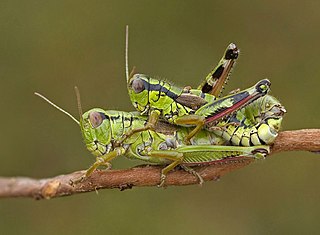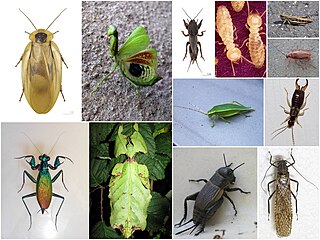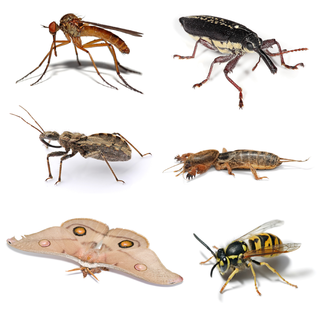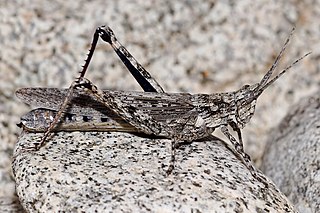
Insects in the family Tettigoniidae are commonly called katydids, or bush crickets. They have previously been known as long-horned grasshoppers. More than 6,400 species are known. Part of the suborder Ensifera, the Tettigoniidae are the only extant (living) family in the superfamily Tettigonioidea.

Orthoptera is an order of insects that comprises the grasshoppers, locusts and crickets, including closely related insects such as the katydids and wetas. The order is subdivided into two suborders: Caelifera – grasshoppers, locusts and close relatives; and Ensifera – crickets and close relatives.

Festivus is a secular holiday celebrated on December 23 as an alternative to the pressures and commercialism of the Christmas season. Originally created by author Daniel O'Keefe, Festivus entered popular culture after it was made the focus of the 1997 Seinfeld episode "The Strike", which O'Keefe's son, Dan O'Keefe, co-wrote.

Ensifera is a suborder of insects that includes the various types of crickets and their allies including: true crickets, camel crickets, bush crickets or katydids, grigs, wetas and Cooloola monsters. It and the suborder Caelifera make up the order Orthoptera. Ensifera is believed to be a more ancient group than Caelifera, with its origins in the Carboniferous period, the split having occurred at the end of the Permian period. Unlike the Caelifera, the Ensifera contain numerous members that are partially carnivorous, feeding on other insects as well as plants.

Bandwings, or band-winged grasshoppers are the subfamily Oedipodinae of grasshoppers classified under the family Acrididae. They have a worldwide distribution and were originally elevated to full family status as the Oedipodidae. Many species primarily inhabit xeric weedy fields, and some are considered to be important locusts:

The Caelifera are a suborder of orthopteran insects. They include the grasshoppers and grasshopper-like insects, as well as other superfamilies classified with them: the ground-hoppers (Tetrigoidea) and pygmy mole crickets (Tridactyloidea). The latter should not be confused with the mole crickets (Gryllotalpidae), which belong to the other Orthopteran sub-order Ensifera.
Stenobothrus eurasius is a species of insect in the family Acrididae. It is found in Hungary and Romania.

Stenobothrus is a genus of grasshoppers found in Asia, Europe, and North Africa.

Chlaenius festivus is a species of ground beetle native to the Palearctic and the Near East. In Europe, it is found in Albania, Austria, the Balearic Islands (doubtful), Bosnia and Herzegovina, Bulgaria, Crete, Croatia, the Cyclades Islands, Cyprus, the Czech Republic, the Dodecanese Islands, European Turkey, mainland France, mainland Greece, Hungary, mainland Italy, Malta (doubtful), Moldova, North Macedonia, Poland, Romania, southern Russia, Slovakia, Slovenia, mainland Spain (doubtful), Ukraine, and Yugoslavia.

Holcosus festivus, commonly known as the Middle American ameiva, Central American whiptail, or tiger ameiva, is a species of whiptail lizard endemic to Central America and northern South America.

Acridoidea is a superfamily of grasshoppers in the order Orthoptera with species found on every continent except Antarctica.

Pteropurpura festiva, commonly known as the festive murex, is a species of predatory sea snail, a marine gastropod mollusk in the family Muricidae, the rock snails. Native to the Eastern Pacific, these sea snails grow to 34–67 mm in length.

Stenobothrus rubicundulus, common name Wing-buzzing Grasshopper, is a species of short-horned grasshoppers in the family Acrididae.
The Tanaoceridae are an insect family in the monotypic superfamily Tanaoceroidea in the suborder Caelifera. They have been called desert long-horned grasshoppers.

The cohort Polyneoptera is a proposed taxonomic ranking for the Orthoptera and all other Neopteran insects believed to be more closely related to Orthoptera than to any other insect orders. They possess biting mouthparts, but undergo little or no metamorphosis.

Stenobothrus lineatus is usually called the stripe-winged grasshopper: it is a species of grasshoppers in the family Acrididae.

Stenobothrus stigmaticus is a species belonging to the family Acrididae subfamily Gomphocerinae and is sometimes called the lesser mottled grasshopper.

Stenobothrini is a tribe of grasshoppers of the family Acrididae, subfamily Gomphocerinae. They occur in Europe, Asia, and northern Africa.

















